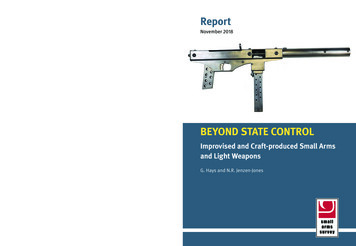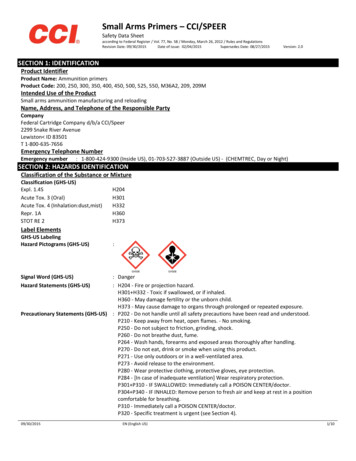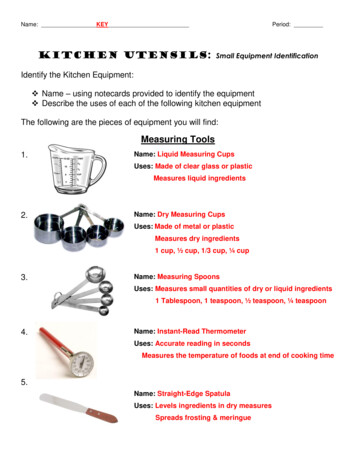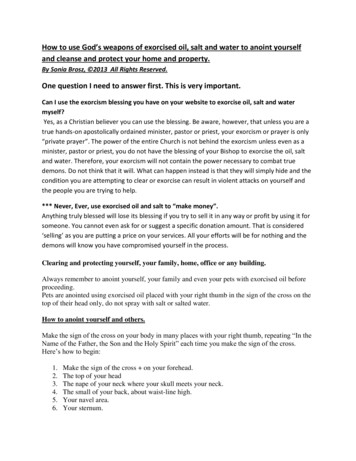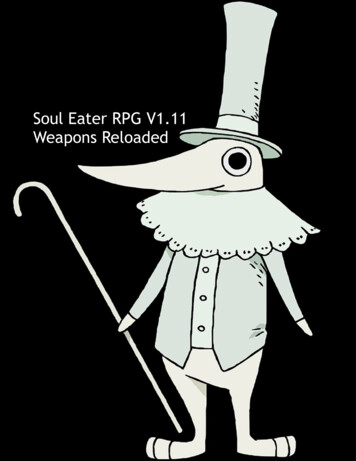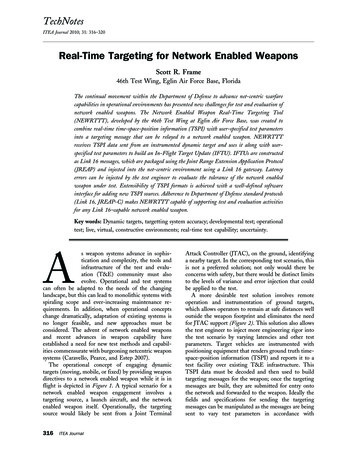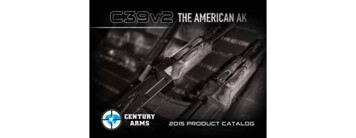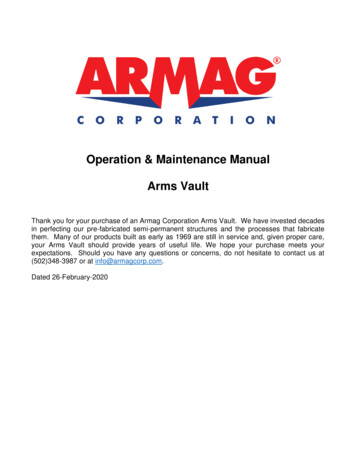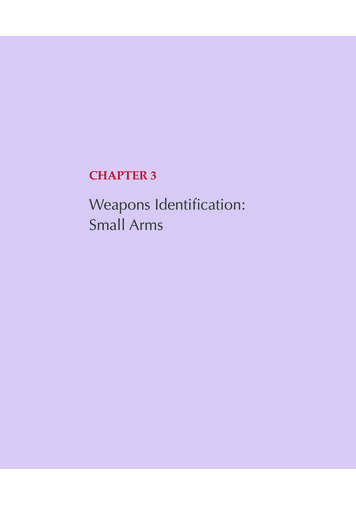
Transcription
CHAPTER 3Weapons Identification:Small Arms
A Guide to the Identification of Small Arms and Light WeaponsIntroductionWhen most people think of ‘guns’, they are thinking of small arms. Broadly speaking, small arms are firearms intended for use by individuals. Small arms are theprimary weapons issued to military, law enforcement, and other armed securitypersonnel, and are widely owned and used by civilians for hunting, sport shooting, and other pursuits. The key characteristics of firearms considered to be smallarms are their portability (they may be transported and operated by a single individual on foot), and their calibre (less than 20 mm) (ARES, 2017; forthcoming).This chapter begins with a brief presentation of key types of small arms, addressing their history and technical development. The chapter then provides anoverview of the most important physical features and markings by which thesearms are identified. It also briefly examines feed devices (such as magazines),accessories, packaging, and shipping documentation, which can provide valuableinformation about the provenance of firearms. Ammunition for small arms is addressed in Chapter 4.HandbookHistory and technical developmentToday’s small arms have their roots in the Victorian era. Some manually-operated rifles, in particular, have changed little since the late 19th century. The revolver predates the invention of modern cartridges, and the archetypal self-loadingpistol created in 1911 as the Colt ‘Government Model’ is still in military use today.Even the automatic machine gun was being sold to authorities around the worldby 1897. By the end of the First World War, all of the categories of small arms nowin use had been invented, if not finalized in their design or application (ARES, 2017).Firearms: a brief descriptionModern firearms take many different forms, but they all have the following components: a ‘stock’ (and/or pistol grip), a ‘barrel’, and the ‘action’, which refers tothe operating components of a weapon.22 One of the main parts of a stock (and,in some guns, the only part) is the ‘butt-stock’. This is the portion of a long gun22 The word ‘firearm’ was originally coined in the medieval period and referred to any weapon making use of fire for destructive effect. Though it became, and remains for most English speakers,synonymous with ‘gun’, a ‘firearm’ can more properly be considered to be a man-portable gun(ARES, 2016a).62
the case of handguns, the pistol grip is used to secure the weapon when firing. Inthe years following the Second World War, many long gun designs also came tofeature a pistol grip. The barrel is the tube through which the projectile (‘bullet’)travels after a cartridge is discharged. The group of components that comprisethe action varies depending on the type of firearm, but includes the componentsthat load and fire ammunition, and that extract and eject fired cartridge cases(ARES, 2017). Figures 3.1 and 3.2 show the general arrangement and key physicalfeatures of a self-loading rifle and self-loading pistol—in this case, a self-loadingrifle with a detachable box magazine and a self-loading pistol, respectively.Figure 3.1 Typical features of a modern military rifleThe ammunition used in most modern firearms is called a ‘cartridge’.Cartridges consist of:a projectile, or bullet, which is fired from the gun;a propellant, which, when ignited by a primer (below), generates the gaspressure that propels the projectile out of the barrel;a primer, which consists of chemicals designed to be ignited by a firing pin inthe weapon; anda cartridge case, which contains the components of a complete round of ammunition and, when the weapon is fired, blocks the escape of gases in a waythat causes pressure to build up behind the projectile (Goad and Halsey, 1982;Jenzen-Jones, 2016a, p. 13).2323 With the exception of caseless ammunition. There are various types of ammunition, many ofwhich are discussed in Chapter 4.63Weapons Identification: Small Arms(such as a rifle or shotgun) which is braced against the shoulder when firing. In
A Guide to the Identification of Small Arms and Light WeaponsFigure 3.2 Typical features of a modern handgunSlide serrationsAccessory railMagazine release (reverse)HandbookMagazine wellNearly all firearms function in the same basic manner. The operator pulls thetrigger, causing an internal mechanism to allow the weapon’s firing pin to strikethe primer, located in the base of the cartridge. The primer ignites the propellant,which generates rapidly-expanding gases as it burns. The build-up of pressurefrom the expanding gas within a sealed chamber (the ‘breech’) pushes the projectile down the barrel, out of the muzzle, and towards the target (see Figure 3.3).The discharge of a firearm is accompanied by a flash and blast at the muzzle, andby recoil that is typically perceived by the user (ARES, 2017).24Modern firearms—with the notable exception of shotguns—primarily featurerifled barrels (see Figure 3.4). Rifling refers to the internal geometry, typicallyeither spiral grooves or polygonal faces inside the bore which engage the projectile and cause it to rotate as it is accelerated up the barrel (see Figure 3.5). This24 This is properly known as ‘perceived recoil’ or ‘felt recoil’, but is often referred to simply as ‘recoil’ (ARES, 2017).64
rately and point first (ARES, 2016a).Firearms make use of a variety of operating systems (‘actions’). At their mostbasic, firearms allow the user to load and chamber a cartridge, fire the weapon,and then extract and eject the fired cartridge case. More complex operating systems allow for semi-automatic and automatic fire, in which the firearm is(re)cocked for the next shot when it is discharged (ARES, 2017).25Figure 3.3 The build-up of gas pressure behind a projectile during the firing sequenceof a firearmNote: The cartridge case and bolt face provide a gas seal.Adapted from: Chinn (1955, p. 4)Figure 3.4 Rifled and smooth-bore barrelsFigure 3.5 Conventional grooved rifling(left) and octagonal polygonal rifling (right)Source: Wikimedia Commons25 Automatic firearms are sometimes described as having ‘fully-automatic’, ‘full automatic’, or ‘fullauto’ operation. While these terms are commonplace in civilian, military, and occasionally eventechnical use, the term ‘automatic’ is sufficient.65Weapons Identification: Small Armsrotation imparts gyroscopic stability to the projectile, ensuring that it flies accu-
A Guide to the Identification of Small Arms and Light WeaponsIn general terms, firearms are either manually-operated or self-loading.Manually-operated firearm: a firearm which relies on the user, rather thanthe potential energy stored within a cartridge, to cycle the weapon (ARES,2017).Self-loading firearm: a firearm which uses the energy stored in a cartridge tocycle the weapon’s action, extracting and ejecting the cartridge case immediately after firing, and chambering a new cartridge from the weapon’s magazine (ARES, 2017).Whether operated by manual or purely mechanical means, each cartridge ina repeating weapon26 is subjected to a similar operating cycle: it is loaded fromthe feed device (or manually loaded) into the gun’s chamber, the bolt is lockedto the rear of the breech, the cartridge is fired, the bolt is unlocked, and the cartridge is then extracted from the chamber and ejected. The vast majority of firearms in existence today are repeating firearms.The most common types of operating system for manually-operated firearmsare break-action, bolt-action, pump-action, and lever-action.27 All of these systemsHandbookrely on the shooter to physically manipulate one or more components of the firearm to unlock the action, extract (and generally eject) the fired cartridge case,chamber a new cartridge, and lock the action (ARES, 2017). These systems aremost common among rifles and shotguns.Self-loading firearms include a wide variety of operating mechanisms. Weapons firing low-powered ammunition typically utilize a simple blowback action.28More powerful ammunition requires a locked breech mechanism. This may berecoil-operated or gas-operated, or use some form of retarded blowback.2926 Generally speaking, a ‘repeating’ firearm is one in which the number of cartridges held in theweapon is greater than the number of barrels, where one or more cartridges are held elsewherethan the firing chamber, and where more than one shot can be fired before the weapon needs tobe reloaded (ARES, 2017). Note that not all weapons make use of a locked breech design.27 Break-action weapons are not repeating firearms, whereas bolt-, pump-, and leveraction types are (ARES, 2017).28 A simple blowback action is one in which the bolt is not locked to the breech on firing, being heldin place only by its own inertia and the return spring. This is only suitable for relatively lowpressure ammunition, such as handgun cartridges or some cartridges for automatic grenadelaunchers (ARES, 2017).29 For explanations of these actions, see ARES (2017).66
and automatic firearms.Semi-automatic firearm: a self-loading firearm which is capable of firingonly one shot with each trigger pull (ARES, 2017).Automatic firearm: a self-loading firearm which is capable of firing multipleshots with a single trigger pull (ARES, 2017).Most rifles in military service today are self-loading designs capable of automatic fire. Semi-automatic versions are available for many of these rifles, whichare used for civilian self-defence, law enforcement, and sporting and huntingapplications in some countries (Jenzen-Jones, 2017d). It can often be difficult tovisually differentiate automatic from semi-automatic variants of the same basicdesign, and so the term ‘self-loading’ is preferred in these cases. Self-loadingpistols are the dominant class of handgun today, in widespread global use byarmed forces, law enforcement and, in many countries, civilians. They are alsoknown as ‘semi-automatic pistols’ (ARES, 2017).HandgunsThe modern term ‘handgun’ came into use in the early 20th century as an umbrella term for non-repeating pistols, self-loading pistols (see Image 3.1), andrevolvers (see Image 3.2).30 Today the self-loading pistol dominates (see Figure3.6); revolvers, though still frequently encountered in the civilian world, are lesscommonly used by militaries or law enforcement personnel. In militaries, pistolsare primarily used as weapons for personal defence only. Pistols are still widelyused by law enforcement agencies, civilians, and criminals, however, primarilybecause they are highly portable and concealable (ARES, 2017).Sub-machine gunsThe sub-machine gun (SMG) was conceived as a fully portable automatic weapon that could be employed at close range by an individual user. SMGs haveshorter barrels than most machine guns and rifles, and typically fire pistol-calibre30 Following their introduction in the 19th century, revolvers were commonly known as ‘revolverpistols’. This label is uncommon today, but remains technically accurate.67Weapons Identification: Small ArmsThe key distinction within self-loading firearms is between semi-automatic
A Guide to the Identification of Small Arms and Light WeaponsImage 3.1 A Soviet Baikal PM 9 18mm self-loading pistolImage 3.2 A Belgian C.F. Galand 12 15.5 mm revolverSource: N.R. Jenzen-Jones/ARESSource: N.R. Jenzen-Jones/ARESFigure 3.6 Typical arrangement of a modern self-loading pistol, showing some internalcomponentsSlideChamberHandbookFiring pinRecoilspringMagazine springFrame68Muzzle
Source: N.R. Jenzen-Jones/ARESammunition from high-capacity magazines (see Image 3.3).31 Handgun ammunition is significantly less powerful than typical rifle ammunition and requires ashorter barrel to achieve its optimum performance. As a result, SMGs have ashorter effective range (typically around 100 m) compared to rifles and machineguns (ARES, 2017). Their blowback system of operation is very simple to manufacture and maintain, and is the dominant operating mechanism for this category of firearm (ARES, 2016a).The term ‘SMG’ also includes most firearms described as ‘personal defenceweapons’ (PDWs) (see Image 3.4). The latter term is primarily a description of aweapon’s intended role rather than a useful technical distinction, although it mayalso imply a use of high velocity ammunition intended to penetrate body armour.32 Generally, SMGs are compact and lightweight.31 Both the common 9 19 mm Parabellum cartridge and a high-capacity drum magazine originallydesigned for the Luger pistol (1902) were incorporated into the first deployed SMG in 1918, theGerman Bergmann MP.18,1 (Forgotten Weapons, 2017b; Popenker and Williams, 2012).32 Two relatively common rounds in service are the 4.6 30 mm HK and 5.7 28 mm FN (ARES,2016a).69Weapons Identification: Small ArmsImage 3.3 An Italian Beretta Model 12S 9 19 mm SMG
A Guide to the Identification of Small Arms and Light WeaponsImage 3.4 A German Heckler & Koch MP7 4.6 30 mm SMGNote: This type of SMG is regarded by some as a ‘personal defence weapon’. There is a void at the base of the pistol grip;the box magazine is absent in this image. There is also a muzzle protector covering the flash hider.HandbookSource: N.R. Jenzen-Jones/ARESIn recent years, the short-range SMG has fallen from favour among militariesand law enforcement agencies, which increasingly use compact variants ofself-loading rifles instead (ARES, 2017; Jenzen-Jones, 2017d).33ShotgunsThe simplest common modern shotgun design, the break-open breech-loadingtype, was fully developed by the 1870s (Greener, 1910; Taylor, 2016). Figure 3.7shows the typical features of a break-action shotgun, in both single-barrel anddouble-barrel configurations. While break-action shotguns are rarely seen in lawenforcement or military service, they remain popular with civilian shooters andcriminals, and are sometimes encountered with shortened (‘sawed-off’) barrelsand/or stocks to enhance their concealability.33 The short-ra
ammunition from high-capacity magazines (see Image 3.3).31 Handgun ammuni-tion is significantly less powerful than typical rifle ammunition and requires a shorter barrel to achieve its optimum performance. As a result, SMGs have a shorter effective range (typically around 100 m) compared to rifles and machine . A ide to te Identification o Small Arms and it Weapons andoo. A ide to te .
